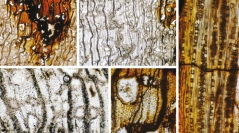

 Geodiversitas
44 (28) - Pages 853-909
Geodiversitas
44 (28) - Pages 853-909The palaeobotanical record of Myanmar (Burma) is poorly documented despite its importance for understanding the evolution of Asian monsoonal ecosystems through time. Here, we describe 20 taxa of fossil wood from 30 silicified specimens collected in the upper lower to lowermost middle Miocene Natma Formation, central Myanmar. These fossils share affinities with modern Fabaceae, Dipterocarpaceae, Burseraceae, Moraceae and Cupressaceae. They include a great variety of fossil dipterocarps (eight species) as found in today’s Southeast Asian rainforests. The nearest living relatives of this assemblage reflect different ecotones of seasonal forests with coastal, mixed to dry deciduous, and wet evergreen species. This reconstruction implies a wet, warm, and monsoonal climate in Myanmar during the late early Miocene. The presence of fossil dipterocarp species typical of wet evergreen forests contrasts with Burmese Eocene dry dipterocarp assemblages and indicates wetter conditions during the Miocene. Our reconstructions support a long-term change from seasonal to everwet ecosystems for dipterocarp trees.
Petrified wood, Fabaceae, Cenozoic, Southeast Asia, dipterocarp, monsoon